Christmas in Texas is usually a time of mild, pleasant weather, and 2005 was no exception. On December 26, a group of Dallas Downriver Club members decided that conditions were ripe for a great day trip in northeast Texas to a river where we had never paddled before. Being the explorers we all are, we decided that the Upper Sabine River near Mineola should be canoed. It had, afterall, a concrete boat ramp at each end of our intended trip, so it MUST be good for powerboats and, therefore, it must be great for canoeing! That was our logic (at the time) and we were sticking to it (AT THAT TIME!) So, we all met at the home of our club president, Bryan Jackson, early in the morning for the 2-hour drive to US Highway 69 between Lindale and Mineola. With temperatures in the lower 50's, we packed for an exciting day trip - comfortable clothing, a few drinks and lunches.
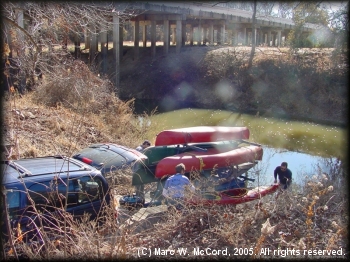 We arrived at the river a little before 11:00 AM, and though we did not know the exact river distance we would be paddling we did know that it was not going to be a long trip. It turned out to only be 11.7 miles down to the FM 1104 bridge where we would take out. What we did not know was what awaited us shortly after we launched. We unloaded our boats and gear, then Tom Taylor accompanied Bryan to the FM 1104 bridge to leave his van and trailer, after which they returned to the US Highway 69 boat ramp to begin our trip. The group included Paul and Ann Boling, Thomas "Jaws" Hansen, Steve Crowe, John Pullman, Bryan, Tom and myself. It was Ann's first river trip ever, but the rest of us have paddled together on many rivers for several years. The easy part of the trip was getting there and getting ready to begin our "adventure". It was not a trip for the fainthearted or weekend warrior. This trip demanded more physical energy from me than any I have EVER expended before, and I have paddled the Brazos River in mid-summer in low-water conditions fighting its infamous headwinds!
We arrived at the river a little before 11:00 AM, and though we did not know the exact river distance we would be paddling we did know that it was not going to be a long trip. It turned out to only be 11.7 miles down to the FM 1104 bridge where we would take out. What we did not know was what awaited us shortly after we launched. We unloaded our boats and gear, then Tom Taylor accompanied Bryan to the FM 1104 bridge to leave his van and trailer, after which they returned to the US Highway 69 boat ramp to begin our trip. The group included Paul and Ann Boling, Thomas "Jaws" Hansen, Steve Crowe, John Pullman, Bryan, Tom and myself. It was Ann's first river trip ever, but the rest of us have paddled together on many rivers for several years. The easy part of the trip was getting there and getting ready to begin our "adventure". It was not a trip for the fainthearted or weekend warrior. This trip demanded more physical energy from me than any I have EVER expended before, and I have paddled the Brazos River in mid-summer in low-water conditions fighting its infamous headwinds!
After about 20 minutes we encountered a tree spanning the entire width of the narrow river, which this far upstream more resembles a creek, and nobody knew how frequently we were going to repeat this event. We had no choice but to portage boats over the tree, which meant getting into the river and mud, then passing boats from one side to the other before climbing back inside. The first major obstacle was one we later referred to as "the point of no return", because after getting over it and heading downriver we decided that it would be too difficult getting back over it coming the other way. Thankfully, the current was very modest, and the portage was not too terribly difficult. Before starting the portage over the tree we decided to eat lunch on the riverbank. That was the last easy thing we would do on this trip.
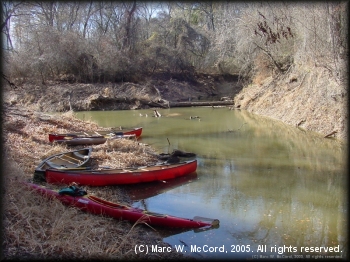 Our journey had just begun! Over the next 11+ miles we would encounter more than 150 such blockages, each forcing us to go over, under or around deadfallen trees and debris piles to make our way downriver. Needless to say, our progress was severely impeded. Tom and I were running GPS tracks, and after 7 hours we had only moved about 5 miles downriver. Darkness was setting in. Steve and Jaws were in kayaks, and were able to move faster than those of us in canoes, all of whom were paddling solo except for Paul and Ann Boling. Paul is a kayaker, but taking Ann on her first trip, he decided to canoe on this day. The two kayaks went ahead of the rest of us in search of the take-out at FM 1104.
Our journey had just begun! Over the next 11+ miles we would encounter more than 150 such blockages, each forcing us to go over, under or around deadfallen trees and debris piles to make our way downriver. Needless to say, our progress was severely impeded. Tom and I were running GPS tracks, and after 7 hours we had only moved about 5 miles downriver. Darkness was setting in. Steve and Jaws were in kayaks, and were able to move faster than those of us in canoes, all of whom were paddling solo except for Paul and Ann Boling. Paul is a kayaker, but taking Ann on her first trip, he decided to canoe on this day. The two kayaks went ahead of the rest of us in search of the take-out at FM 1104.
As darkness approached Tom stopped along the riverbank to remove his headlamp from his Camelback hydration pack that he normally wears when paddling. It seems that Tom was the only one in our group who brought a headlamp. After all, this WAS a day trip, so why would we need headlamps? Unfortunately, Tom forgot to put his hydration pack back on, and we were a significant distance downriver when he realized it. Night had already befallen us, but Tom ventured back upriver to try and find his pack. He never saw it again! The rest of us waited for his return since he had the only headlamp. We needed his boat to be out front so we could see the logjams before we hit them in the dark.
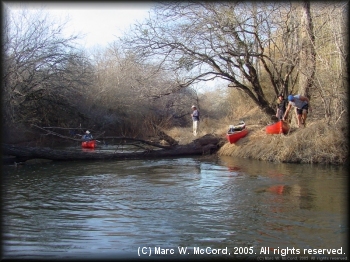 Needless to say, getting down the Sabine in the dark with major blockages ever 50-500 feet was very difficult, and more than a little tiring. We were worn out from paddling a few feet, getting out, dragging boats over tree trunks or portaging around them on the banks, then getting back in our boats, only to repeat the process a few minutes later. There were times when we portaged two or three obstructions without getting back into our boats because they were so close together.
Needless to say, getting down the Sabine in the dark with major blockages ever 50-500 feet was very difficult, and more than a little tiring. We were worn out from paddling a few feet, getting out, dragging boats over tree trunks or portaging around them on the banks, then getting back in our boats, only to repeat the process a few minutes later. There were times when we portaged two or three obstructions without getting back into our boats because they were so close together.
The temperature was dropping, but thankfully it was a mild night. Jaws was wearing shorts and a short sleeve shirt. None us brought cold weather clothing. It was, after all, a DAY TRIP! We also had no headlamps, extra food or camping gear because it was a DAY TRIP! Ann was the only cigarette smoker in the group, and her supply of cigarettes was starting to run low. She figured we would be off the river in a few hours and she could get back to civilization where she could buy more of those cancer sticks. It did not happen, and she ended up bumming cigar stogies from Bryan until the wee hours of the morning. At different times Bryan, John and Tom had fallen into the river and gotten wet. We were burning calories at a world record pace, so they managed to stay relatively warm, aided by the very light winds we encountered, until we reached our riveside campsite.
Like the troopers we are, we continued paddling into the night, and by 10:00 PM, we had only covered about 6.5 miles, so we were barely halfway to our destination. Bryan was clicking his emergency alarm on his keychain in hopes of hearing his van horn, but it was an effort made in vain. The sounds we heard were of large beavers slapping the water with their tails, feral hogs rooting along the banks and millions of night critters like crickets and locusts that were "singing" to us. Occasionally, we heard muttered "expletives deleted" as we encountered yet another logjam.
Finally, at about 10:30 PM, I saw lights on the river bank, then heard human voices. It was Jaws and Steve, whom we had not seen in over three hours. At last, we had arrived at our take-out. WRONG! They were on river right, and our take-out was on river left, still several miles and many more logjams below where we were. Aproaching their voices, I began to paddle harder, not yet knowing that we had not arrived at Bryan's van. That was when I found the tree laid across the river with its trunk exactly face high. I hit it running, smashed my nose and nearly fell out of my boat. It hurt like hell! Now, in addition to being tired, hungry and a little cold, I was also in physical pain from trying to dislodge a huge tree with my face. Bad form, Marc!
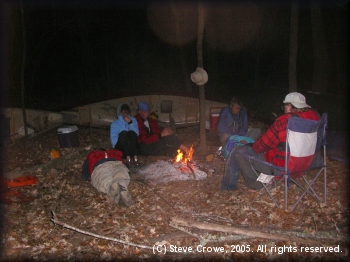 After landing, and sizing up our situation, we decided that the only logical thing to do was to make camp on the riverbank and paddle out in the morning. It turned out to be the right choice. We gathered wood and built a fire, then arranged three canoes to act as a wind block. I broke out my First Aid kit and began doling out Ibuprophen, Acetamenifen and Naproxin Sodium according to the preference of each person in our group. We had a small quantity of food left over from lunch, so we divided it equally and had a light snack, then attempted to settle in for a miserable night sleeping on the cold, damp ground while awaiting first light. It is amazing how soundly people can sleep when exhausted, even if they are uncomfortable doing it. Snores were coming from everywhere.
After landing, and sizing up our situation, we decided that the only logical thing to do was to make camp on the riverbank and paddle out in the morning. It turned out to be the right choice. We gathered wood and built a fire, then arranged three canoes to act as a wind block. I broke out my First Aid kit and began doling out Ibuprophen, Acetamenifen and Naproxin Sodium according to the preference of each person in our group. We had a small quantity of food left over from lunch, so we divided it equally and had a light snack, then attempted to settle in for a miserable night sleeping on the cold, damp ground while awaiting first light. It is amazing how soundly people can sleep when exhausted, even if they are uncomfortable doing it. Snores were coming from everywhere.
Jaws was really cold because of his lack of long sleeves and longlegged pants, so we gave him a couple of emergency space blankets - those foil things that every paddler should carry with them just in case they need to get warm. He put it over his head, then donned his hat to hold it there while wrapping the rest of it around his body before moving closer to the fire to warm up. Ann described Jaws as looking like a giant Jiffy Pop man. Bryan and John were also cold from having gotten wet, but they were quickly warmed by the fire, and soon Bryan was snoring in deep sleep. Fortunately, the temperature only dipped to the mid-40's, because none of us had brought cold weather clothing. This was, after all, a DAY TRIP!
First light brought us a vision we did not want to see - a series of logjams that required an immediate portage of more than 100 yards, and we were still reeling from all the portages of the previous day. The upside was that we just knew our take-out had to be close. Actually, it was nearly 5 miles further downriver, and we were barely over halfway through our trip. It is probably good that we did not know that at the time, because it might have forced us to consider just ending it all right there! It was another pleasant Texas winter day, with mild temperatures and sunny skies. We were still smiling, probably more from dilerium than from our joy of still being on the river.
We paddled a few feet, then portaged, paddled a few feet, then portaged - the cycle was unending. We almost never, ever see logjams on the rivers we paddle, and now we know why - all the logjams were on THIS river. But, we were determined to reach our take-out and Bryan's van, so we continued with smiles on our faces, if not in our heart. Privately, I was cursing the river gods for dropping all that timber in our path. The upside was that this trip made me rethink my disdain for the Brazos River, which on a bad day is just low and slow with moderate to strong headwinds. Suddenly, I began to appreciate the Brazos a little more.
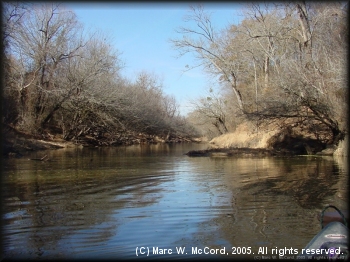 We ran into a couple of places where we actually we able to paddle a short distance without a portage, and we relished that opportunity to just sit in our boats and paddle. Finally, we saw the FM 1104 bridge and instantly knew that we had survived a night of hell of the Upper Sabine River. It was a welcome sight. We were tired, hungry and ready to get home to hot baths and warm beds. Bryan dropped the trailer, then returned Tom to the put-in to retrieve his vehicle while the rest of us began loading boats and gear onto the trailer. Upon their return, we connected the trailer to Bryan's van, loaded up our weary bodies in the two vehicles, then headed for home.
We ran into a couple of places where we actually we able to paddle a short distance without a portage, and we relished that opportunity to just sit in our boats and paddle. Finally, we saw the FM 1104 bridge and instantly knew that we had survived a night of hell of the Upper Sabine River. It was a welcome sight. We were tired, hungry and ready to get home to hot baths and warm beds. Bryan dropped the trailer, then returned Tom to the put-in to retrieve his vehicle while the rest of us began loading boats and gear onto the trailer. Upon their return, we connected the trailer to Bryan's van, loaded up our weary bodies in the two vehicles, then headed for home.
Now, you would think that this was the end of the story, and for rational, sane paddlers it would have been. Nobody, however, ever accused us of being rational or sane. Just three weeks later Tom came up with the idea of a 3-day trip on the Colorado River between Webberville and Bastrop, a place where Steve, Tom and I paddled over the New Year's weekend. Since Tom had two extra days off work and the rest of us had no commitments stopping us, Tom suggested that we first return to the Upper Sabine, paddle in lightly-loaded boats to retrieve his Camelback hydration pack with binoculars and paddling gloves inside, and then head down to the Austin area to begin our Colorado River trip. Well, disease can spread quickly during the Texas winter, and Bryan developed a "serious sinus infection" which then lept over 50 miles to Steve's house, and at the last minute they both cancelled their participation leaving just Tom and me to enjoy this adventure.
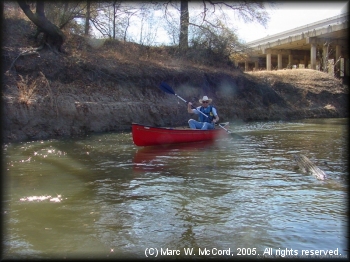 Not to be daunted by such setbacks, and eyeing those extra miles as contributing toward our "Most Miles Paddled" club trophy for 2006, Tom and I went anyway. Unfortunately, we did not get as early a start as we preferred due to some last minute delays on Tom's part. This should have been a warning sign, but we were not paying attention. We planned to launch at US 69, paddle down, grab Tom's stuff, then paddle back upriver. We had a general idea about where he left his pack, and about how many miles and portages we would encounter, so we departed around 1:00 PM from the bridge. Upon reaching "the point of no return" we began to realize just how insane this really was. After all, Tom had already replaced the lost items, and for all we knew a feral hog might have already co-opted Tom's hydration pack with the binoculars and gloves inside. You know how those feral hogs are!
Not to be daunted by such setbacks, and eyeing those extra miles as contributing toward our "Most Miles Paddled" club trophy for 2006, Tom and I went anyway. Unfortunately, we did not get as early a start as we preferred due to some last minute delays on Tom's part. This should have been a warning sign, but we were not paying attention. We planned to launch at US 69, paddle down, grab Tom's stuff, then paddle back upriver. We had a general idea about where he left his pack, and about how many miles and portages we would encounter, so we departed around 1:00 PM from the bridge. Upon reaching "the point of no return" we began to realize just how insane this really was. After all, Tom had already replaced the lost items, and for all we knew a feral hog might have already co-opted Tom's hydration pack with the binoculars and gloves inside. You know how those feral hogs are!
By 7:00 PM, it was getting very dark, and we had seen no signs of Tom's stuff. But, we did have on cold weather clothing and we both had headlamps with fresh batteries. I called the ball on our search, and so we turned around our boats and began the arduous struggle back upriver toward our put-in/take-out. That almost imperceptable current going downriver became a strong current when we had to get back upriver through narrow openings where a venturi effect squeezed the water through trees and created strong downriver currents. In daylight, it would not have been such a big deal, but not being able to clearly see where we were going was a different animal altogether.
I had brought my Old Town H2Pro whitewater boat on this trip because it is 14 inches shorter and 5 inches narrower than my Old Town Cascade. I figured the smaller boat would be more maneuverable and might allow me to slide under some of the blockages that I had to go over or around in December. For the most part, it worked as planned. Around 10:00 PM, as I was passing under a downed tree, I failed to lean forward enough to completely clear the trunk. My PFD rubbed the tree and stopped the boat. The downriver current quickly rolled the boat and dropped me in the water. My airbags kept the boat on the surface, but that water was ice cold, and I immediately knew that I was in trouble. I instantly summoned Tom, who was about a tenth of a mile ahead of me, in a voice that was about three octaves higher than normal. I had gone from a baritone to a first soprano in a matter of two seconds.
Tom had no swiftwater rescue training at the time, though he is a certified paramedic. In this case, he did not know what to do, so I had to give him instructions. The water was deep where I was holding onto my boat, which contained my digital camera and First Aid kit. It took more than ten minutes to get me and my boat out of the river, though it seemed more like ten hours. I was completely soaked, having gone underwater before resurfacing with my headlamp still shining brightly. Once out of the river, I discovered just how cold I really was and I instantly recognized the impending signs of hypothermia - a paddlers worst nightmare (well, perhaps encountering a mama grizzly bear with cubs COULD be worse!)
I instructed Tom to immediately begin gathering firewood, statewide burn ban be damned, while I went through my First Aid kit to get my fire starter sticks and fireplace lighter. In a matter of minutes we had a roaring fire, and were certain that it would probably attract the attention of an airplane or helicopter whose pilot would then report a wildfire to the local fire marshall or the Texas Forest Service. Thankfully, that never happened. I instructed Tom to prepare me some hot water with sugar in it to begin raising my core temperature. Instead, Tom had some spiced apple cider mix that tasted a lot better than ordinary sugar and water. I gulped down one cup, then asked for another. Those two cups made a world of difference and I could feel my core temperature rising quickly. But, I was still very wet and very cold.
Now, I probably should have stripped naked to shed the wet clothing from my body, but I was wearing base layer clothing that dries quickly, so I just kept those things on. Tom wrapped me in a space blanket and I sat so near the fire that a steam cloud hovered all around me. It required more than 5 hours to get me and my clothing dry and warm enough to continue paddling. Then, Tom gave me the bad news. He went to empty the remaining water from my canoe and it was frozen - solid! We knew that it was cold, but had no idea just how cold, and personally, I am glad not to have known. It would only have exacerbated the problem.
About 3:00 AM, we began paddling back upriver toward Tom's vehicle, and every portage meant getting into the river and/or the muddy banks. Fortunately, we never got deeper than mid-calf, and we were both wearing our NRS Workboots, so our feet were protected. On the December trip Tom had worn his sandals and torn up the tops of his feet, so he acquired a pair of boots like mine, and now he wears them religiously. We finally reached "the point of no return" and instantly knew that we were just a short distance from warmth and safety. When we saw the US 69 bridge, and the lights of cars on the highway, we were relieved to have made it, though we were both VERY cold. It was 5:45 AM.
Only when we got into Tom's Blazer and cranked up the heater did we realize just how cold were really were - the outside air temperature was reading 24 degrees farenheit! It took nearly 30 minutes, though it seemed like an eternity, to get warm, and then we began loading boats and gear. We got colder during the time we were loading up to depart than when we were paddling out, probably because we now knew just how cold it had gotten overnight. I was wishing that I had worn my drysuit with a complete fleece liner underneath, but as my dad would have said, "Wish in one hand..."
We drove into Lindale, got a motel room, took hot showers, ate a huge breakfast, then returned to our room for several hours of much-needed sleep. It cost us our first day on the Colorado, but we drove on down to Austin, then began a shortened trip the next day, relieved that we had survived an icy challenge that could have caused serious injury or death. Once again, my swiftwater rescue training had paid off in spades.
Not to be daunted by this experience, we decided to put together a class for our club and other friends who are paddlers where we work in teams putting people into the same situation we faced that night, then instructing them in how to survive. We are determined to turn what could have been a bad experience into something useful for our fellow paddlers who may find themselves in a similar situation someday. There is no teacher like personal experience, and I now know what it feels like to be wet and cold on a remote river where outside help is not going to arrive. So far, none of our fellow paddling compatriots has taken us seriously about having this rescue class, but we still intend to do it - SOMEDAY!
I can say, unequivocally, that it is going to take an offer of a boatload of one hundred dollar bills to get me back on the Upper Sabine! As "W" would say, "Fool me once, shame on you. Fool me twice - you can't fool me twice." In my case, you cannot fool me three times. No gear is worth that much effort, especially after it has already been replaced.


